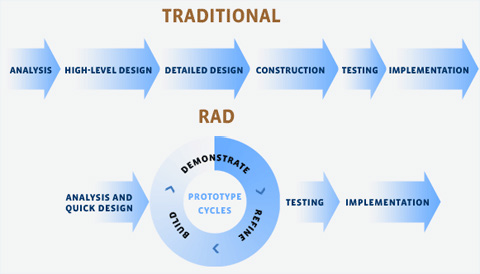Which of the following software development methodology uses minimal planning and in favor of rapid prototyping?
A. Agile Developments
B. Software prototyping
C. Rapid application development
D. Component based development
A. Agile Developments
B. Software prototyping
C. Rapid application development
D. Component based development
Correct Answer: C
Explanation:
Explanation:
Rapid application development (RAD) is a software development methodology that uses minimal planning in favor of rapid prototyping. The “planning” of software developed using RAD is interleaved with writing the software itself. The lack of extensive perplanning generally allows software to be written much faster, and makes it easier to change requirements.
Rapid Application Development

Four phases of RAD
Requirements Planning phase – combines elements of the system planning and systems analysis phases of the Systems Development Life Cycle (SDLC). Users, managers, and IT staff members discuss and agree on business needs, project scope, constraints, and system requirements. It ends when the team agrees on the key issues and obtains management authorization to continue.
User design phase – during this phase, users interact with systems analysts and develop models and prototypes that represent all system processes, inputs, and outputs. The RAD groups or subgroups typically use a combination of Joint Application
Development (JAD) techniques and CASE tools to translate user needs into working models. User Design is a continuous interactive process that allows users to understand, modify, and eventually approve a working model of the system that meets their needs.
Construction phase – focuses on program and application development task similar to the SDLC. In RAD, however, users continue to participate and can still suggest changes or improvements as actual screens or reports are developed. Its tasks are programming and application development, coding, unit-integration and system testing.
Cutover phase – resembles the final tasks in the SDLC implementation phase, including data conversion, testing, changeover to the new system, and user training. Compared with traditional methods, the entire process is compressed. As a result, the new system is built, delivered, and placed in operation much sooner.
The following were incorrect answers:
Agile Development – Agile software development is a group of software development methods based on iterative and incremental development, where requirements and solutions evolve through collaboration between self-organizing, cross-functional teams.
Software prototyping- Software prototyping, refers to the activity of creating prototypes of software applications, i.e., incomplete versions of the software program being developed. It is an activity that can occur in software development and is comparable to prototyping as known from other fields, such as mechanical engineering or manufacturing.
Component Based Development – It is a reuse-based approach to defining, implementing and composing loosely coupled independent components into systems. This practice aims to bring about an equally wide-ranging degree of benefits in both the short-term and the long-term for the software itself and for organizations that sponsor such software.
Reference:
CISA review manual 2014 Page number 195
Rapid application development (RAD) is a software development methodology that uses minimal planning in favor of rapid prototyping. The “planning” of software developed using RAD is interleaved with writing the software itself. The lack of extensive perplanning generally allows software to be written much faster, and makes it easier to change requirements.
Rapid Application Development

Four phases of RAD
Requirements Planning phase – combines elements of the system planning and systems analysis phases of the Systems Development Life Cycle (SDLC). Users, managers, and IT staff members discuss and agree on business needs, project scope, constraints, and system requirements. It ends when the team agrees on the key issues and obtains management authorization to continue.
User design phase – during this phase, users interact with systems analysts and develop models and prototypes that represent all system processes, inputs, and outputs. The RAD groups or subgroups typically use a combination of Joint Application
Development (JAD) techniques and CASE tools to translate user needs into working models. User Design is a continuous interactive process that allows users to understand, modify, and eventually approve a working model of the system that meets their needs.
Construction phase – focuses on program and application development task similar to the SDLC. In RAD, however, users continue to participate and can still suggest changes or improvements as actual screens or reports are developed. Its tasks are programming and application development, coding, unit-integration and system testing.
Cutover phase – resembles the final tasks in the SDLC implementation phase, including data conversion, testing, changeover to the new system, and user training. Compared with traditional methods, the entire process is compressed. As a result, the new system is built, delivered, and placed in operation much sooner.
The following were incorrect answers:
Agile Development – Agile software development is a group of software development methods based on iterative and incremental development, where requirements and solutions evolve through collaboration between self-organizing, cross-functional teams.
Software prototyping- Software prototyping, refers to the activity of creating prototypes of software applications, i.e., incomplete versions of the software program being developed. It is an activity that can occur in software development and is comparable to prototyping as known from other fields, such as mechanical engineering or manufacturing.
Component Based Development – It is a reuse-based approach to defining, implementing and composing loosely coupled independent components into systems. This practice aims to bring about an equally wide-ranging degree of benefits in both the short-term and the long-term for the software itself and for organizations that sponsor such software.
Reference:
CISA review manual 2014 Page number 195